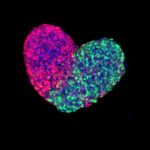Lien vers Pubmed [PMID] – 35737842
Lien DOI – 10.1073/pnas.2113651119
Proc Natl Acad Sci U S A 2022 06; 119(26): e2113651119
The high-dimensional character of most biological systems presents genuine challenges for modeling and prediction. Here we propose a neural network-based approach for dimensionality reduction and analysis of biological gene expression data, using, as a case study, a well-known genetic network in the early Drosophila embryo, the gap gene patterning system. We build an autoencoder compressing the dynamics of spatial gap gene expression into a two-dimensional (2D) latent map. The resulting 2D dynamics suggests an almost linear model, with a small bare set of essential interactions. Maternally defined spatial modes control gap genes positioning, without the classically assumed intricate set of repressive gap gene interactions. This, surprisingly, predicts minimal changes of neighboring gap domains when knocking out gap genes, consistent with previous observations. Latent space geometries in maternal mutants are also consistent with the existence of such spatial modes. Finally, we show how positional information is well defined and interpretable as a polar angle in latent space. Our work illustrates how optimization of small neural networks on medium-sized biological datasets is sufficiently informative to capture essential underlying mechanisms of network function.

